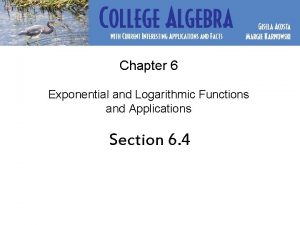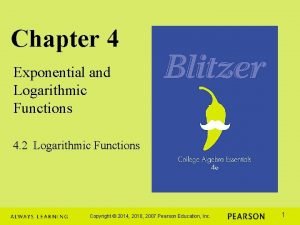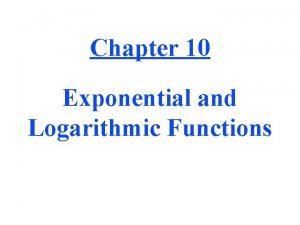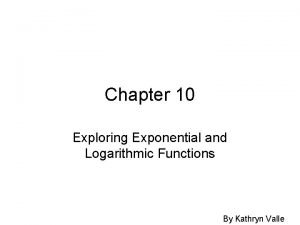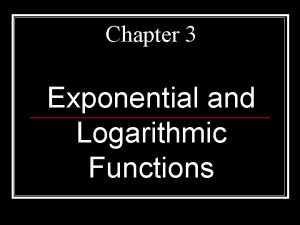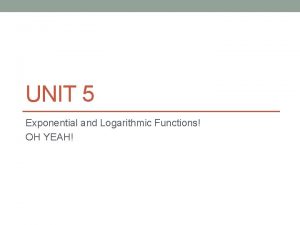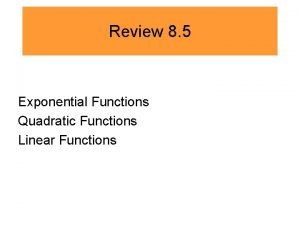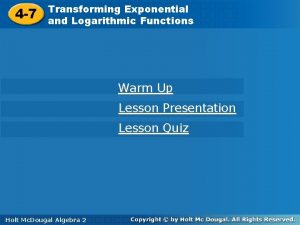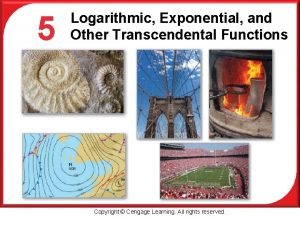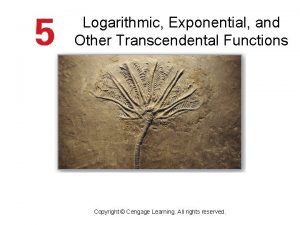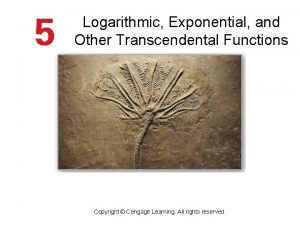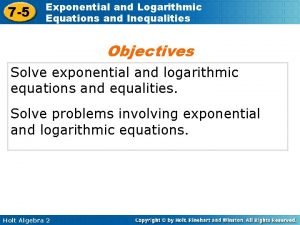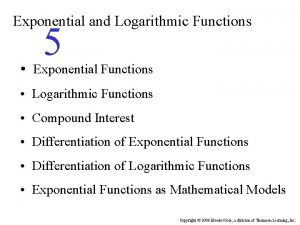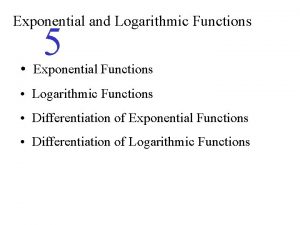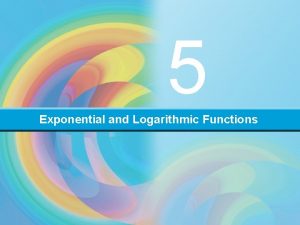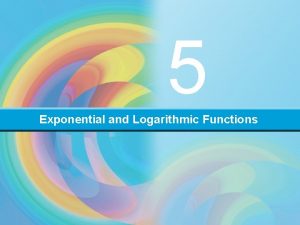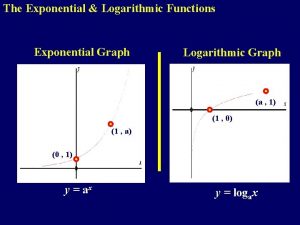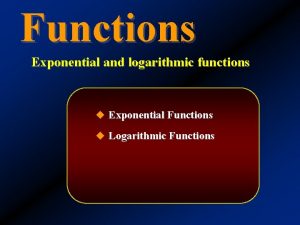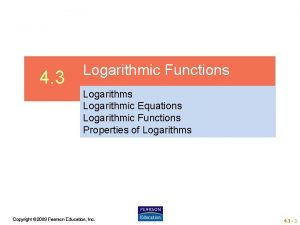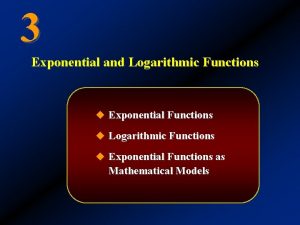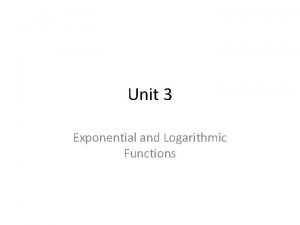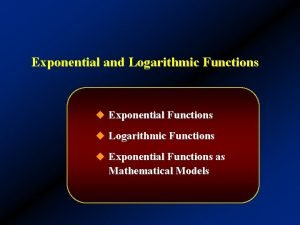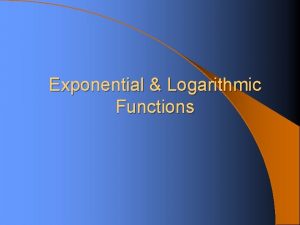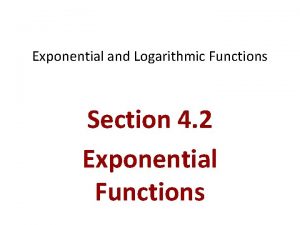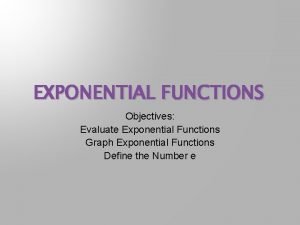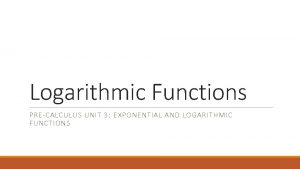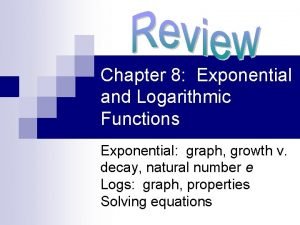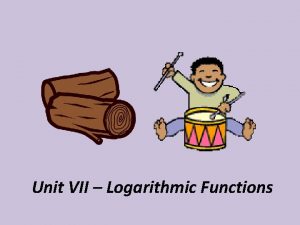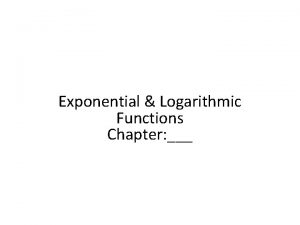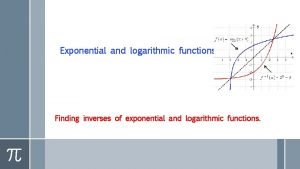Chapter 3 Exponential and Logarithmic Functions Section 3





















- Slides: 21

Chapter 3 Exponential and Logarithmic Functions

Section 3 -1 Exponential Functions and Their Graphs

Pensamiento n "La verdadera felicidad se logra en el esfuerzo, no en la diversión. “ Bonifacio

Exponential Functions

We have dealt with algebraic functions, which included polynomial and rational functions

We will study two types of nonalgebraic functions: exponential and logarithmic functions.

Definition: The exponential function f with base a is denoted by f(x) = ax where a > 0 , a ≠ 1 and x is any real number

Graphs of Exponential Functions

Note n Graphs of exponential functions have similar characteristics

Example 1. In the same coordinate plane, sketch the graph of each function a. f(x) = 2 x b. g(x) = 4 x

f(x) = 4 x f(x) = 2 x

Example 2. In the same coordinate plane, sketch the graph of each function a. F(x) = 2 -x b. G(x) = 4 -x

F(x) = 2 -x G(x) = 4 -x

Note - Observe F(x) = 2 –x = f(-x) and G(x) = 4 –x = g(-x) - F is a reflection of f (in y-axis)

Note - The graphs are typical of the exponential functions a x and a –x - They have one y-intercept and one horizontal asymptote (x-axis) - They are continuous

Basic Characteristics Graph of y = ax a>0, a≠ 1 Graph of y = a-x a>0, a≠ 1 - Domain (-∞, ∞) - Range (0 , ∞) - y-intercept (0 , 1) - Increasing - Decreasing - x-axis HA - Continuous

Excersis n a. b. c. d. Graph each transformation of the graph f(x) = 3 x in the same coordinate plane g(x) = 3 x + 1 h(x) = 3 x – 2 k(x) = - (3 x ) j(x) = 3 –x

The natural base e

Notes - e ≈ 2. 71828… (irational) - This number is called the natural base - The function f(x) = e x is called the natural exponential function

Example Sketch the graph of each natural exponential a. f(x) = 2 e 0. 24 x b. g(x) = ½ e -. 058 x

 Chapter 6 exponential and logarithmic functions answers
Chapter 6 exponential and logarithmic functions answers Chapter 4 exponential and logarithmic functions
Chapter 4 exponential and logarithmic functions Graphing logs and exponentials worksheet
Graphing logs and exponentials worksheet Lesson 10-2 exponential growth and decay
Lesson 10-2 exponential growth and decay Chapter 10 exponential and logarithmic functions answers
Chapter 10 exponential and logarithmic functions answers Chapter 5 exponential and logarithmic functions
Chapter 5 exponential and logarithmic functions Expanding logarithmic functions
Expanding logarithmic functions Chapter 9 exponential and logarithmic functions answer key
Chapter 9 exponential and logarithmic functions answer key Chapter 9 exponential and logarithmic functions answer key
Chapter 9 exponential and logarithmic functions answer key Chapter 5 exponential and logarithmic functions answer key
Chapter 5 exponential and logarithmic functions answer key Chapter 5 exponential and logarithmic functions
Chapter 5 exponential and logarithmic functions Chapter 3 exponential and logarithmic functions
Chapter 3 exponential and logarithmic functions Unit 8 exponential and logarithmic functions
Unit 8 exponential and logarithmic functions Examples of exponential equations
Examples of exponential equations How to tell if an equation is linear or quadratic
How to tell if an equation is linear or quadratic Transforming exponential and logarithmic functions
Transforming exponential and logarithmic functions Inverse functions logarithmic and exponential
Inverse functions logarithmic and exponential Logarithmic exponential and other transcendental functions
Logarithmic exponential and other transcendental functions Solving exponential and logarithmic functions calculator
Solving exponential and logarithmic functions calculator Inverse function graph examples
Inverse function graph examples Integration of exponential
Integration of exponential 7-5 exponential and logarithmic equations and inequalities
7-5 exponential and logarithmic equations and inequalities
